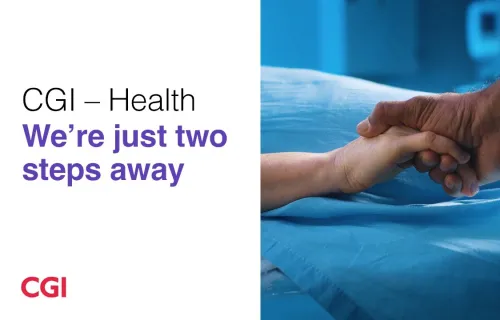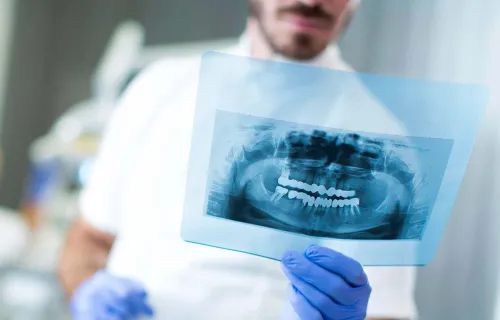Hamilton Health Sciences (HHS) is a family of hospitals serving the 468,000 citizens of the city of Hamilton and the more than two million residents of Central-South Ontario, Canada. HHS is one of Canada’s largest teaching hospitals, and its 10,000 staff, physicians and volunteers provide a comprehensive range of acute, non-acute and specialized services, catering to health care needs from preconception through to aging adults. Chedoke Hospital, Hamilton General Hospital, Henderson General Hospital, McMaster Children’s Hospital and McMaster University Medical Centre are all part of the HHS family, along with the Juravinski Cancer Centre, the most comprehensive centre for cancer care and research in the entire region.
The challenge
Although Hamilton Health Sciences operates its five hospitals on four campuses as a single, combined facility, each hospital still had its own independent health records department, resulting in significant challenges managing patient health records.
A patient at HHS could end up with as many as four different health records, for example, requiring considerable effort by medical staff when pulling together the comprehensive clinical picture of that patient’s history they use to ensure delivery of the best possible care.
With the consolidation of the hospitals and the growing number of patients, the paper health records at HHS were becoming very difficult to manage. And with 10 million pages of patient records being generated annually, filing rooms in the Health Records Department were crammed full, making it difficult to file and retrieve records. With a vast amount of prime hospital space already being consumed for filing, records could only be retained for 48 months before they had to be put on microfilm, making them even more difficult to access.
Competition for use of patient charts also posed problems. Physicians, clinicians and records department could all easily be trying to use a patient’s charts at the same time. This often resulted in multiple copies of each record being used concurrently by staff in different departments – each adding their own written notes and completed forms – thus creating additional work for records staff to pull these together into a single consolidated health record.
A new approach was needed that would consolidate the staff, activities and records in the five separate records departments into a single operation with a streamlined records management process that would make accurate, up-to-date patient health records quickly and easily accessible by all authorized HHS staff.
The final straw, however, was HHS’s decision to standardize on the use of MEDITECH’s Health Care Information System as the clinical operations system for all its hospitals. The paper records filing system in use at two of the HHS facilities was not compatible with the way that MEDITECH works. Every paper record at those two sites – each with two large filing rooms each containing as many as 300,000 records – would have to be taken off the shelves, renumbered, resorted and then put back on the shelves again.
After finding that it would take upwards of $700,000 for such an undertaking, senior management at HHS decided their money would be better spent on a longer-term solution for their records management problems – one that provided far more future potential than their current paper-based system could ever offer.
The strategy
In the Spring of 2002, HHS, faced with the growing problems of managing a paper-based health records system, began looking at document imaging and electronic document management solutions available in the marketplace, including the CGI Sovera Health Information Management solution.
“After doing some checking around, we found that CGI has an excellent track record and was one of very few companies in this market that has any real implementation experience, especially when it comes to interfacing to the MEDITECH system,” explains Mark Farrow, CIO & AVP, Information & Communications Technologies at HHS. Commenting further on the HHS decision to work with CGI, Farrow adds, “We needed solid, proven technology, and we were confident we’d get that with Sovera, which was already operational at more than 100 hospital sites.”
Sovera, an electronic health records management system, would provide a single, consolidated medical records platform and a single, consistent set of patient record indexing for the online storage and retrieval of patient health records across all HHS facilities. With Sovera, all new health records created would be scanned and stored as electronic documents accessible online anywhere, anytime by authorized staff. The health record information maintained by Sovera would complement the patient information already stored in the MEDITECH database and would constitute the long-term legal health record for each patient.
“CGI helped us take a staged approach to the Sovera implementation that minimized disruption to ongoing hospital operations, and allowed any kinks to be worked out in a manageable environment,” says Mary Bedek, Manager, Health Records for HHS.
Implementation started with the health records in the Emergency Department – a contained operation consisting of one department and one manager at each of three sites, and small charts (averaging only 12 forms per chart). The rollout continued from there to include Day-Care, Inpatient and then finally the Outpatient records, with each area presenting a progressively more complex environment – more staff, more departments interacting, larger, more-complex health records containing more forms, and increasing demands on records accessibility and speed.
Although the technical implementation of Sovera at HHS went smoothly, it was the people change management issues and need for changes to business processes that posed the real challenges for the HHS and CGI team. During the initial document scanning period for example, 1,000 ‘ad hoc’ forms were discovered to be in use. To ensure they were suitable for legal records purposes, HHS’s Office of Document Production, supported by forms and clinical committees, had to redesign these forms to ensure they complied with standards and best practices.
“CGI made good use of its background experience working with other hospitals to help us with sample forms and working through various aspects associated with document imaging, such as the proper use of barcoding,” says HHS’s Farrow.
There were people challenges as well. Medical and records staff who were accustomed to being able to flip through the old paper records and easily find what they were looking for based on different colors used for different forms, would no longer have this ‘visual queuing’ to help them once the records were online. And as their health records environment changed from paper-based to online, HHS staff had to deal with a shift in the way records are perceived and used – from the seldom-accessed ‘archival world’ of the paper records to the ‘real-time’ world of online records that are quickly and easily accessible forever.
For the medical staff, many of whom had been sheltered from significant exposure to the use of computers to date, the Sovera project put technology right in their backyards, leaving them little option but to get involved. HHS conducted a variety of training and one-on-one sessions for the medical staff to help them build the skills and confidence to embrace it and use it every day.
And to make things really interesting, the SARS (Sudden Acute Respiratory Syndrome) outbreak occurred right in the middle of the Sovera implementation. Considerable dedication and creative thinking were needed by both parties to keep the project moving forward during a time of potential crisis, when far more important matters suddenly took top priority.
Commenting on CGI’s contribution to the Sovera implementation, Mark Farrow says, “They were great to work with and very responsive to our needs. Their industry experience and in-depth knowledge of Sovera were very helpful to us throughout the entire process.”
The results
By scanning and storing health records electronically, Sovera has eliminated most of HHS’s health records management problems. For starters, it has freed up considerable storage space that can now be better used for patient care delivery. And by making records instantly available anytime, anywhere, Sovera has eliminated the problems associated with trying to collect patient information from multiple facilities to create a single, integrated health record, and with trying to find that record again once it’s been filed away.
Previously, for example, records department staff spent a lot of time and effort collecting clinical data on each discharged acute-care patient to send to the Canadian Institute for Health Information as legislated by the Ontario government to support province-wide trend analyses. Making that information readily available online has significantly increased productivity and allowed health records staff to focus more on value-added 'knowledge work' such as chart review, coding and abstracting, and looking for trends in healthcare episodes.
Sovera also helps HHS comply with other legislation, including PHIPA (Personal Health Information Protection Act), Ontario’s Health Bill 31 and lockbox regulations, which places specific requirements on hospitals with respect to health record privacy and security. With charts now available in electronic form, and by granting access on a ‘permissive’ basis, Sovera makes it easy for the hospital to control access and audit who’s accessing the records – right down to the individual pages – making it much easier to comply with regulations such as PHIPA than previously possible.
Now that doctors and clinicians can access a patient’s chart online from virtually anywhere, competition for use of the charts disappears. Physicians can quickly and easily login to the Sovera system – even from home – to review charts, add their own notes, and resolve chart deficiencies – missing items such as completed forms, test results, notes and signatures – that the system automatically flags for them to resolve.
No longer bound by the constraints of working with physical paper records, those in the department doing the coding and abstracting for each health record to meet government reporting requirements are no longer tied to a specific hospital site and to the records created there. With the records now online, they can work from virtually anywhere. Many of them have already been moved to an offsite location, and plans are underway for them to work from home. This not only improves the lifestyle of the employees by giving them greater flexibility and eliminating the daily commute, it boosts employee productivity, frees up valuable hospital space and enables the records department to better manage its workload.
“It seemed that we were never quite able to take stock of our paper records system and how we’d get to our EHR (Electronic Health Record) goal,” explains Aulenback. “Through CGI’s efforts, however, we now have a much better understanding of where and how to start, what the problems might be along the way, and where the biggest benefits will come from,” she concludes.




